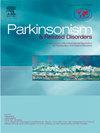Vacuolar protein sorting 13 homolog C was associated with motor progression in Parkinson's disease
IF 3.1
3区 医学
Q2 CLINICAL NEUROLOGY
引用次数: 0
Abstract
Introduction
The SNP rs2414739 of Vacuolar protein sorting 13 homolog C(VPS13C) gene was identified to be linked with Parkinson's Disease (PD).
Objectives
Explore the clinical progression feature of PD patients with rs2414739 variant.
Methods
Longitudinal data were obtained from the Parkinson's Progression Marker Initiative (PPMI) cohorts. Linear mixed models were used to test the effects of VPS13C with the progression of PD assessed by different scales.
Result
A total of 333 patients with PD were included and divided into rs2414739 carriers (n = 138) and noncarriers (n = 195). Patients with PD carrying VPS13C mutation had slower progression, assessed by total scores of MDS-UPDRS (II+III) (β = −1.834, p = 0.000, 95%CI: −2.767, −0.901) than noncarriers. The effect of VPS13C was significant both in the rate of change of UPDRS-II scores (β = −0.284, p = 0.028, 95%CI: −0.537, −0.031) and UPDRS-III scores (β = −0.894, p = 0.009, 95%CI: −1.558, −0.228). We further divided VPS13C carriers into heterozygous and homozygous carriers, and found that the rate of change of UPDRS(II+III) (β = −1.165, p = 0.039, 95%CI: −2.265,−0.062) scores and UPDRS-III scores (β = −9.521, p = 0.041, 95%CI: −18.524,−0.532) were significantly slow in heterozygous VPS13C carriers. There was only 20 homozygous VPS13C carriers, which was too small a sample to perform the analysis.
Conclusion
VPS13C was associated with slow motor progression in PD patients.

液泡蛋白分选13同源物C与帕金森病的运动进展相关。
摘要:液泡蛋白分选13同源基因C(VPS13C) SNP rs2414739与帕金森病(PD)相关。目的:探讨rs2414739基因变异PD患者的临床进展特征。方法:从帕金森病进展标志物倡议(PPMI)队列中获得纵向数据。采用线性混合模型检验VPS13C对不同量表PD进展的影响。结果:共纳入333例PD患者,分为rs2414739例携带者(n = 138)和非携带者(n = 195)。通过MDS-UPDRS (II+III)总分(β = -1.834, p = 0.000, 95%CI: -2.767, -0.901)评估,携带VPS13C突变的PD患者比非携带者进展较慢。VPS13C对UPDRS-II评分的变化率(β = -0.284, p = 0.028, 95%CI: -0.537, -0.031)和UPDRS-III评分的变化率(β = -0.894, p = 0.009, 95%CI: -1.558, -0.228)均有显著影响。我们进一步将VPS13C携带者分为杂合型和纯合型,发现杂合型VPS13C携带者UPDRS(II+III)评分(β = -1.165, p = 0.039, 95%CI: -2.265,-0.062)和UPDRS-III评分(β = -9.521, p = 0.041, 95%CI: -18.524,-0.532)的变化率明显较慢。VPS13C纯合载体只有20个,样本量太小,无法进行分析。结论:VPS13C与PD患者运动缓慢进展相关。
本文章由计算机程序翻译,如有差异,请以英文原文为准。
求助全文
约1分钟内获得全文
求助全文
来源期刊

Parkinsonism & related disorders
医学-临床神经学
CiteScore
6.20
自引率
4.90%
发文量
292
审稿时长
39 days
期刊介绍:
Parkinsonism & Related Disorders publishes the results of basic and clinical research contributing to the understanding, diagnosis and treatment of all neurodegenerative syndromes in which Parkinsonism, Essential Tremor or related movement disorders may be a feature. Regular features will include: Review Articles, Point of View articles, Full-length Articles, Short Communications, Case Reports and Letter to the Editor.
 求助内容:
求助内容: 应助结果提醒方式:
应助结果提醒方式:


